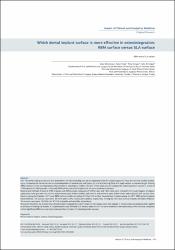Which dental implant surface is more effective in osteointegration: RBM surface versus SLA surface
Özet
Aim: The surface characteristics of an implant direct the wound healing and are an important factor for osteointegration. There are very few studies evaluating or comparing the clinical success of osteointegration of sandblasting with larger grit and acid etching (SLA) and rough surface as required by grit blasting (RBM) surfaces, which are important surface factors in selecting an implant. The aim of this study was to evaluate the osteointegration success in a total of 4793 implants in 2005 patients in SLA and RBM surface cylindrical implants of the same trademark and type.
Material and Methods: A total of 4793 implants and 2005 patients composed of 943 females and 1062 males were included in this study. Regions of implant applications were grouped into anterior and posterior parts of the mandible and anterior and posterior parts of the maxilla and evaluated with success rates.
Results: Among the implants, 1877 were RBM surface and the remaining 2675 had SLA surface. Seventy-four implants among the 1877 RBM surface implants failed (%96.06). The success rates were 94.75 % and 97.22%, maxilla and mandible, respectively. Among the 2675 SLA surface implants, 93 failed (%96.53). The success rates were 95.29% and 97.11% in maxilla and mandible, respectively.
Discussion: Recently, the studies have demonstrated increased bone and implant contact areas and a high degree of osteoconductive property when applied to surfaces in histological studies. In the presented study, RBM and SLA surface implants with the same trademark and same design were clinically compared, and no significant difference was found between them in terms of osteointegration success.
Kaynak
Annals of Clinical and Analytical MedicineCilt
12Sayı
7Bağlantı
https://hdl.handle.net/20.500.12868/1631https://link.springer.com/article/10.1007/s10798-021-09713-2


















